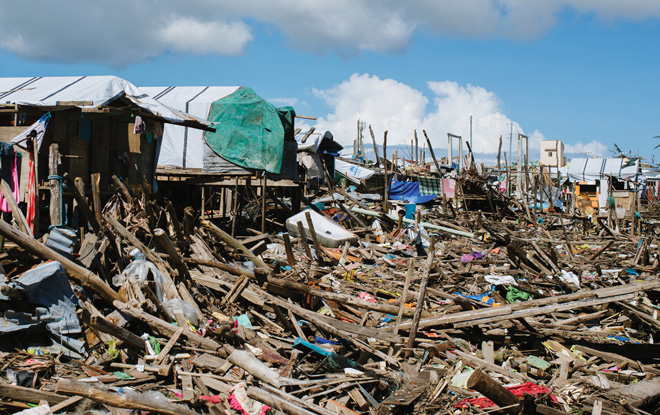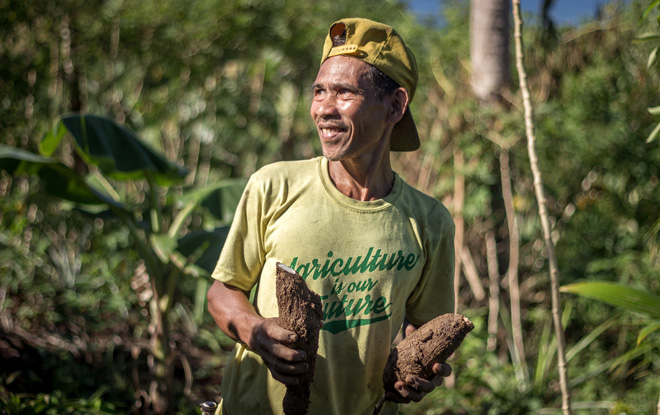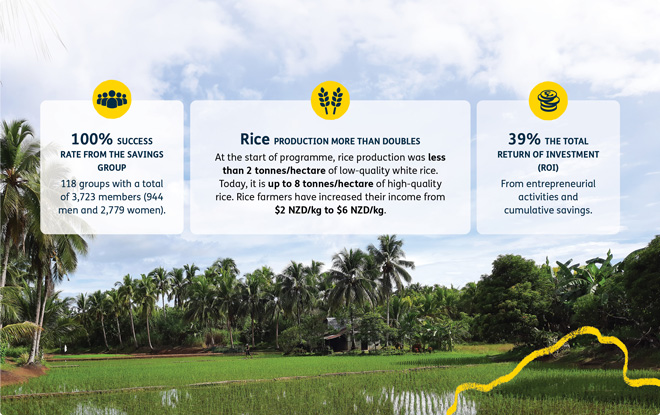Typhoon Haiyan-devastated communities now thriving
5891 0
Ten years on from one of the world’s most ferocious cyclones, communities in the Philippines are thriving thanks to a long-term recovery project.
During one of the most powerful typhoons in recorded history, winds from the Category 5 "Super Typhoon" Haiyan struck the Philippines in November 2013. With wind speeds up to 314km per hour, trees were shredded, and homes were blown apart. One of the most devastating forces was the unexpected storm surges.
Some were estimated to be more than seven metres high, they claimed hundreds of lives as they swept away everything in their path. An estimated 16 million people were affected by Haiyan, and 6,300 people lost their lives.
Many of Tearfund's supporters generously gave to provide emergency relief and create safe spaces for children in the coastal communities of Marabut and Basay in Samar.

Category 5 Typhoon Haiyan caused widespread devastation in the Philippines in 2013.
Such was the destruction from Haiyan, that staff working for our partner had to walk into these communities as roads were washed out or strewn with trees and debris.
Emergency responses for events such as cyclones help meet immediate needs and generally last three to six months. However, when this funding ends, many aid agencies pull out, and communities are left to recover on their own.
As many responding agencies began pulling out of Samar after the emergency phase ended, the people in these communities faced enormous challenges. With the destruction of an estimated 33 million coconut palms, the coconut industry—the main cash crop for these communities—was in tatters. This meant communities faced a seven-year wait until new trees came into production.
Following the cyclone, many farmers relied on unsustainable fishing for their incomes. Fish stocks were rapidly becoming depleted, and many people became vulnerable to exploited labour and human trafficking.
But thanks to the vision of Tearfund, our partners, and supporters, help for the recovery of disaster-affected communities was on its way. It was in this challenging situation that Tearfund, our partner, and supporters began a transformational journey which ended in November 2023—10 years after Haiyan.
While assessing the initial emergency response, Tearfund Programmes Specialist Kevin Ridell strongly felt we couldn’t leave the people in this predicament as they had no real sources of sustainable livelihoods to recover well from this tragedy.
Tearfund and our partner identified the potential for a long-term project to help families achieve economic self-sufficiency and develop resilience to all types of disasters, and donors joined the journey. This was called the Western Samar Coastal Agriculture Project.

Farmer Vergilio with his cassava.
Farmers formed groups to learn sustainable farming techniques and collectively supply markets across the Philippines. They were no longer farming just to feed their families and earn a little on the local market.
Members also saved a little each week to create a pool of funds from which members could borrow at low interest rates to buy equipment and farming inputs such as seeds and fertilisers to improve their crop yields.
To support farmers' efforts, the programme provided the necessary infrastructure, such as irrigation systems and postharvest facilities. These facilities enable farmers to ensure their produce is stored, processed and kept fresh to markets in cities such as Manila.
Communities now have facilities to process their rice and are adding value to the products they grow, such as cassava chips, peanut butter, banana chips and more.
As the Philippines experiences up to 20 cyclones a year, another focus has been preparing communities for disasters. Being coastal, these communities are particularly vulnerable.
Today, they work together when disaster strikes. While no two storms are the same, this resilience was evident when Typhoon Rai hit in 2021, resulting in no homes destroyed and no crops lost.
The programme and facilities were handed back to the community in November 2023. While this project can never erase the loss and devastation experienced by these communities, they are now thriving, and their lives and well-being have improved thanks to this long-term recovery programme.
We want to thank all our supporters who have helped our partner walk alongside these communities, and the Ministry of Foreign Affairs and Trade for catching the vision to help “build back better”.

Want to learn more about how we respond to disasters? Click here